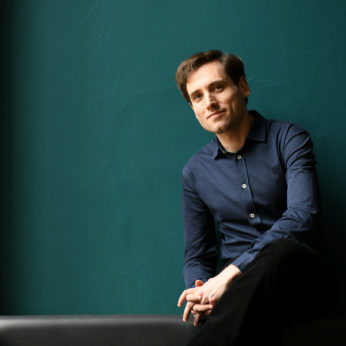Composer: Johannes Brahms (b. 1833 - d. 1897)
Performance date: 27/06/2022
Venue: Bantry House
Duration: 00:45:20
Recording Engineer: Eduardo Prado, Ergodos
Instrumentation: 2vn, va, vc, pf
Instrumentation Category:Piano Quartet/Piano Quintet
Artists:
Pavel Haas Quartet (Veronika Jarůškova, Marek Zwiebel [violins], Dana Zemtsov [viola], Peter Jarůšek [cello]) -
[String Quartet]
Boris Giltburg -
[piano]

Johannes Brahms [1833-1897]
Piano Quintet in F minor Op.34
1. Allegro non troppo
2. Andante, un poco adagio
3. Scherzo: Allegro
4. Finale: Poco sostenuto, Allegro non troppo, Presto non troppo
I am leaving on Monday for Vienna! I’m looking forward to it like a child. Of course I don’t know how long I shall stay… The C minor Symphony is not ready; on the other hand a string quintet (2 cellos) in F minor is finished. I should like to send it to you and know what you have to say about it. This letter from Brahms to his friend Dietrich in 1862 on the eve of his departure to Vienna is the first inkling we have of this early version of the piano quintet.
During this first visit to Vienna, Brahms not only helped to copy parts of Die Meistersinger for three concert performances given by its composer, but he also spent many hours studying Schubert’s manuscripts. These were so unknown and so untouched that Brahms was able to preserve the writing sand from them in a little box he kept specifically for that purpose. When Brahms returned to Vienna the next year as conductor of the Singakademie, he had been persuaded by the violinist Joachim to rewrite the Quintet as a two piano Sonata which he premiered with pianist Tausig at an all Brahms concert early in 1864.
However, Clara Schumann, who along with Joachim was Brahms’ most intimate musical collaborator, had been enthusiastic about the original Quintet and was abruptly dismissive of the two piano version as merely an arrangement. This forced Brahms to recast the work yet again into its final familiar form. Hermann Levi speaking for all of Brahms’ friends wrote the Quintet is beautiful beyond words… you have turned a monotonous work for two pianos into a masterpiece of chamber music, the like of which we haven’t seen since the year 1828.
The Allegro immediately presents us with the dramatic contrast of the work, between emotional introspection and explosive defiance. The sinuous opening idea is brutally interrupted by its ebullient sequel before returning in a grand unison statement. The second subject is melancholy at first and later atmospherically sinister. It is treated at reflective but tender length in the development section. This tenderness returns in the coda in the strings alone before being swept aside in the final accelerando.
The slow movement begins with all those studies of Schubert’s scores, where an infinitely extendable one bar refrain is stretched far far beyond Schubert to a great romantic song. The central section with the piano’s strummed accompanying chords is more gentle, less passionate, but more complex in instrumentation. The song then returns, a trifle wistful now, despite its beauty.
Brahms since his earliest works had relished the challenge of the Scherzo and he specialised in these comparatively short, intensely dynamic and virile explosions, often after a deceptively low key start. This one is driven by an unquenchable rhythmic impulse and a fusillade of hammered syncopation between piano and strings. The big singing tune of the Trio seems to be in strong contrast but is in fact a development of the Scherzo theme.
The hectic close of the Scherzo is then met by the extraordinary introduction to the Finale, sonorous and intense, a chromatically ambiguous reminder of the dark side before the folk-influenced rondo that follows. This opens with a sturdy Haydnesque cello tune, clearly intended as a relaxed contrast, followed by a second subject that re-establishes the fevered romanticism of the introduction. The main theme returns only after a salon-style digression that reminds us of the B major Piano Trio. The massive and rhythmically unpredictable coda brings this supremely self-confident work to an impetuous close.
Francis Humphrys
Copyright © 2024 West Cork Music. All rights reserved.
Designed and developed by Matrix Internet